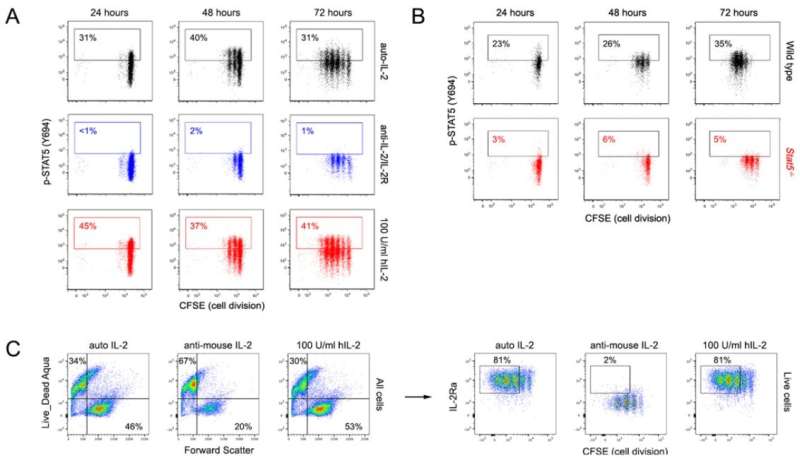December 22, 2022 feature
The secret lives of T cells: They derive energy from a master regulator that has been poorly understood, until now

T cells aren't the first immune forces on the scene, they arrive after being alerted by other immune system warriors that a microbe has invaded or a cancer has silently seeded.
Exactly how T cells obtain the energy they need to build a massive army in the face of infiltrators has been the subject of speculation, theory and decades-long laboratory inquiries.
Now, scientists are taking a deeper dive into the question, and their investigations are shedding new light on an array of dynamic biological activities that help bolster T cell populations. Their research demystifies how T cells can power their growth and proliferation when disease emerges and T cell strength is in greatest need.
An ongoing series of studies at the National Institutes of Health in Bethesda Maryland is delving into a key pathway that helps provide the metabolic energy to boost T cell proliferation.
Writing in Science Immunology, a collaborative group of scientists has zeroed in on the STAT5 pathway. STAT stands for signal transducers and activators of transcription. Seven STATs have been identified, but STAT5 is of particular interest because it is involved in crucial cellular signaling and plays a key role in helper T cell growth and expansion. The STAT5 pathway controls responses to the cytokine interleukin-2 (IL 2), according to a new bioinformatics study involving cell cultures.
The research by Dr. Alejandro Villarino and colleagues demonstrates how STAT5 regulates the metabolism of T helper cells and underscores how the efficiency of this pathway impacts immunity.
"T cell activation requires changes in metabolism needed for the energy demands of rapid growth and proliferation," Villarino writes in Science Immunology. "Cytokines that engage common gamma chain receptors on T cells are critical to promoting metabolic changes needed for [T cell] activation.
"Common gamma chain family cytokines are central to these processes," Villarino added, noting that STAT5's role has remained poorly understood. But the team's findings have opened a new window of understanding. Indeed, the team proposes a central role for STAT5 in T helper cell metabolism.
"Using genome-, transcriptome-, and metabolome-wide analyses, we demonstrate that STAT5 is a master regulator of energy and amino acid metabolism in CD4+ T helper cells," Villarino and colleagues concluded.
CD4+ T cells, also known as T-helper cells or just plain old TH cells, perform many immune functions. They're arguably the most important cells in the adaptive immune system because they are critically needed for a vast number of key immune responses. Adaptive immunity, also known as the acquired system or cellular immunity, is the arm of the immune system dominated by T cells and B cells.
TH cells help activate B cells, which in turn, secrete antibodies. TH cells spur macrophages to destroy ingested microbes, but they also help activate cytotoxic T cells to kill infected cells. In short, TH cells help orchestrate the adaptive immune response, and it is because of TH cells' central role in immunity that researchers have sought to better understand how they derive and sustain their energy.
Beyond the research underway by Villarino and colleagues, T cells in general have captured the public's imagination in recent years amid the ongoing COVID-19 pandemic. People want to know how T cell memory works, and more important, whether mRNA vaccines prompt T cell proliferation. The answer, according to U.S. federal research is, yes.
Experts say findings from these studies suggest that the presence of T cells may help explain why vaccinated people are protected from severe disease caused by various subtypes of the omicron variant. Future vaccines, these scientists say, may be designed to specifically enhance T cell responses.
But the National Institutes of Health research, led by Villarino and collaborators, wanted answers to deeper biological questions whose answers can help add context to T cell activity in devastating diseases. Most of all, the research examines how STAT5 functions and why it has been dubbed the master regulator of amino acid metabolism in T helper cells.
As Villarino and colleagues explain, TH cell proliferation and activation are often regulated through cytokines that interact with the cells' gamma chain—c?—receptors. One common signaling pathway used by c? cytokines, including IL-2, is the STAT5 pathway, the master regulator.
The team turned to genomic, transcriptomic and metabolomic analyses to better understand how the STAT5 pathway impacts the T cell amino acid metabolism, for example. Researchers found that STAT5 has a cascading effect, triggering yet another signaling pathway known as mTOR, an essential regulator of T helper cell metabolism. "The data presented here coalesce to establish that STAT5 is central to T cell metabolism and further suggest that this property is relevant for lymphoid malignancies," they say.
More information: Alejandro V. Villarino et al, A central role for STAT5 in the transcriptional programing of T helper cell metabolism, Science Immunology (2022). DOI: 10.1126/sciimmunol.abl9467
© 2022 Science X Network

















